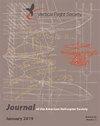后掠无铰倾转旋翼高速无失稳巡航气动弹性载荷与稳定性
IF 1.4
4区 工程技术
Q2 ENGINEERING, AEROSPACE
引用次数: 0
摘要
利用美国马里兰大学开发的新型旋翼机气动力学求解器,对一种带后掠叶的无铰轮毂倾转旋翼机进行了全面研究。求解器通过假设的美国陆军结果和1972年波音222型测试数据进行了验证。将不稳定速度从80%转数的20°后掠提高到405 kt,提高了75 kt以上。关键的机理是气动中心移位。代价是控制系统和叶片负荷的增加。提供对物理学的基本理解。涡旋颤振不是涡旋颤振,而是涡旋空气共振的临界现象。在供电模式下进行预测是必要的。至少第一个旋翼襟翼,滞后和扭转模式需要包括在内。转子空气动力学应使用翼型表;机翼空气动力学对空气共振并不重要。分析表明,13.5%厚的机翼可以实现高速飞行,但需要用现代设备进行系统的风洞试验来进一步验证。本文章由计算机程序翻译,如有差异,请以英文原文为准。
Aeroelastic Loads and Stability of Swept-Tip Hingeless Tiltrotors toward High-Speed Instability-Free Cruise
A hingeless hub tiltrotor with swept-tip blades was examined comprehensively with a new rotorcraft aeromechanics solver developed at the University of Maryland. The solver was verified with hypothetical U.S. Army results and validated with Boeing Model 222 test data from 1972. A 20° sweep back from 80%R increased instability speed to 405 kt, an improvement of more than 75 kt. The key mechanism is the aerodynamic center shift. The trade-off is the increase in control system and blade loads. Fundamental understanding of physics is provided. Proprotor air resonance emerged as the critical phenomenon, not whirl flutter. Predictions in powered mode are necessary. At least the first rotor flap, lag, and torsion modes need to be included. Rotor aerodynamics should use airfoil tables; wing aerodynamics is not important for air resonance. Analysis shows high-speed flight is achievable with 13.5% thick wings but systematic wind tunnel tests with modern equipment are necessary for further validation.
求助全文
通过发布文献求助,成功后即可免费获取论文全文。
去求助
来源期刊

Journal of the American Helicopter Society
工程技术-工程:宇航
CiteScore
4.10
自引率
33.30%
发文量
36
审稿时长
>12 weeks
期刊介绍:
The Journal of the American Helicopter Society is a peer-reviewed technical journal published quarterly (January, April, July and October) by AHS — The Vertical Flight Society. It is the world''s only scientific journal dedicated to vertical flight technology and is available in print and online.
The Journal publishes original technical papers dealing with theory and practice of vertical flight. The Journal seeks to foster the exchange of significant new ideas and information about helicopters and V/STOL aircraft. The scope of the Journal covers the full range of research, analysis, design, manufacturing, test, operations, and support. A constantly growing list of specialty areas is included within that scope. These range from the classical specialties like aerodynamic, dynamics and structures to more recent priorities such as acoustics, materials and signature reduction and to operational issues such as design criteria, safety and reliability. (Note: semi- and nontechnical articles of more general interest reporting current events or experiences should be sent to the VFS magazine
 求助内容:
求助内容: 应助结果提醒方式:
应助结果提醒方式:


